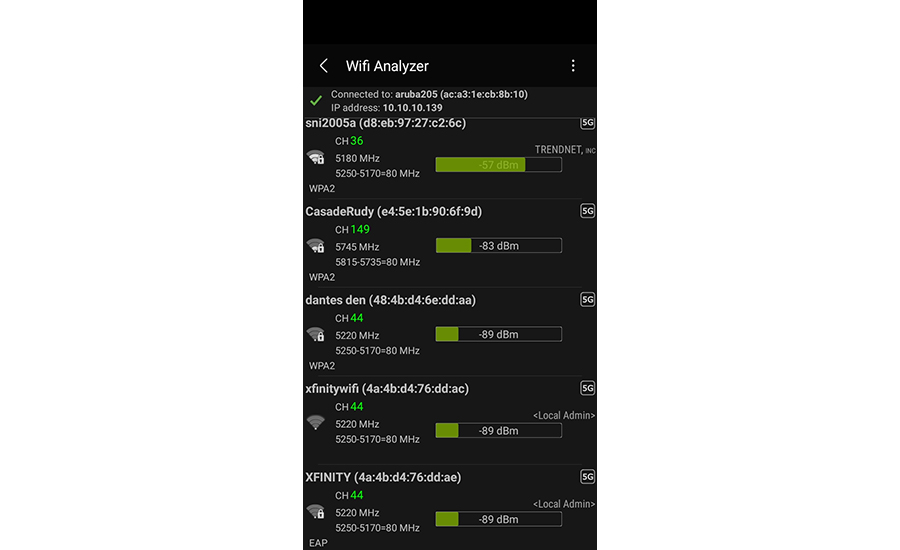Networking technology has completely changed the devices and systems that our industry installs today. Piggy backing on existing IP network connections and devices has provided profound benefits for our customers, while in some cases reducing installation and system costs. Everybody wins.
The most valuable and effective IP networking connectivity is Wi-Fi, providing wireless communications for IoT and system devices, with their transmissions and supervision carried through the air.
While Wi-Fi has become ubiquitous there can be difficulties when there’s a concentration of separate IP/Wi-Fi networks that can interfere with each other due to radio spectrum congestion. For example, from my desk in downtown Chicago my cell phone detects around a dozen Wi-Fi access points from my systems and my neighbors.
This Wi-Fi congestion is illustrated in the following screenshot, which is only a portion of the networks I referenced:

As you can see, there are a number of networks that are on the same Wi-Fi 802.11ac 5 GHz channel (44) and potentially will interfere with each other.
To enhance Wi-Fi capabilities the standards body has released 802.11ax, which is also termed as Wi-Fi 6. Apparently, the powers that be have decided to make Wi-Fi terminology easier for all by using simple numbers. Wi-Fi 6 operates at 2.4 GHz and 5 GHz, and its fellow Wi-Fi 6E technology works at 6 GHz. Using 6 GHz, which hasn’t yet been used by previous Wi-Fi technologies, will open new channels and allow for more overlapping Wi-Fi coverage with minimal interference.
The potential performance numbers for the new Wi-Fi 6 remote devices and access points are quite impressive, with a potential of 9608 Mbits/sec, which compares to the existing 802.11ac (Wi-Fi 5) at 6933 Mbits/sec and 600 Mbits/sec for the 10-year-old 802.11n (Wi-Fi 4).
Using a combination of technologies allows Wi-Fi 6 access points and devices to communicate multiple streams of two-way data simultaneously. Wi-Fi 6 “beamforming” directs signals directly toward the remote device from the access point, while orthogonal frequency division multiple access (OFDMA) provides a method where multiple devices can be communicated with using the same signal packets on different sub-frequencies.
Other important Wi-Fi 6 upgrades include more comprehensive encryption (WP3) and can increase the battery life of devices with Target Wake Time (TWT), where the access point can in essence “wake up” the radios in devices that haven’t been transmitting, reducing battery wear.
Wi-Fi 6E provides the benefits of Wi-Fi 6 while transmitting on the 6GHz frequency band, which can provide 1,200 MHz of usable bandwidth to deliver high amounts of data over shorter distances.
“Wi-Fi 6E provides the benefits of Wi-Fi 6 while transmitting on the 6GHz frequency band which can provide 1,200 MHz of usable bandwidth to deliver high amounts of data over shorter distances.”
As we have seen in the past, the initial devices with Wi-Fi 6 available will be expensive, but just like with other technologies the prices will fall and Wi-Fi 6 is backwards compatible with Wi-Fi 5 (802.11ac) devices. And if the full potential of a Wi-Fi 6 or 6E access point is to be used, all communicating devices must have the Wi-Fi 6 protocols included.
Once Wi-Fi 6 becomes a common type of access point, the advantages for security systems will likely be seen by wireless IP camera streams, which can be bigger bandwidth than previous wireless video connectivity.
One subtle advantage of Wi-Fi 6 is that the data throughputs will be close to or exceed that of cabled Ethernet, making either type of connection suitable for high-bandwidth usage.
The requirements for available network bandwidth will never decrease; look at the explosion of streaming services that rely on Wi-Fi to deliver the final connection from the internet to their video monitor. Wi-Fi 6 is just the next phase in increased wireless communication bandwidth, and we can all benefit.







